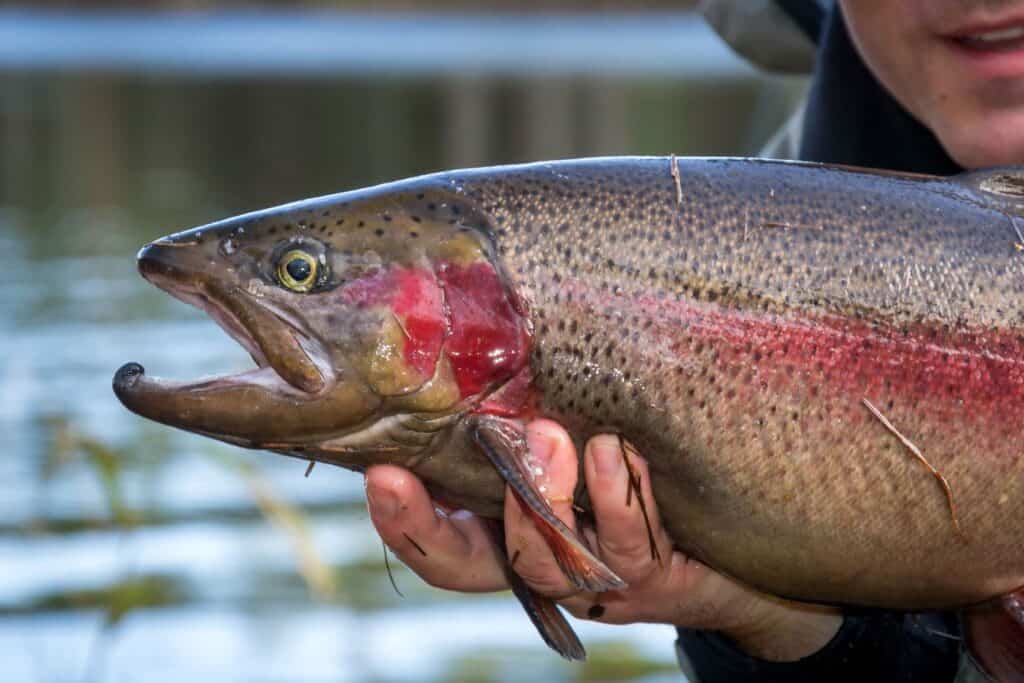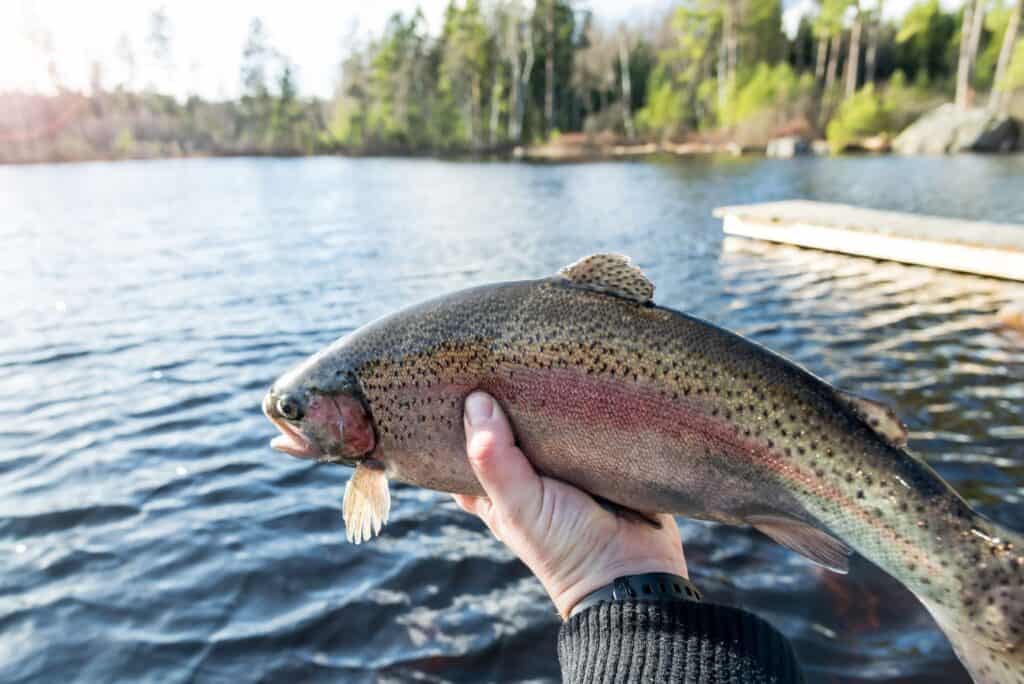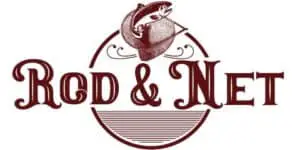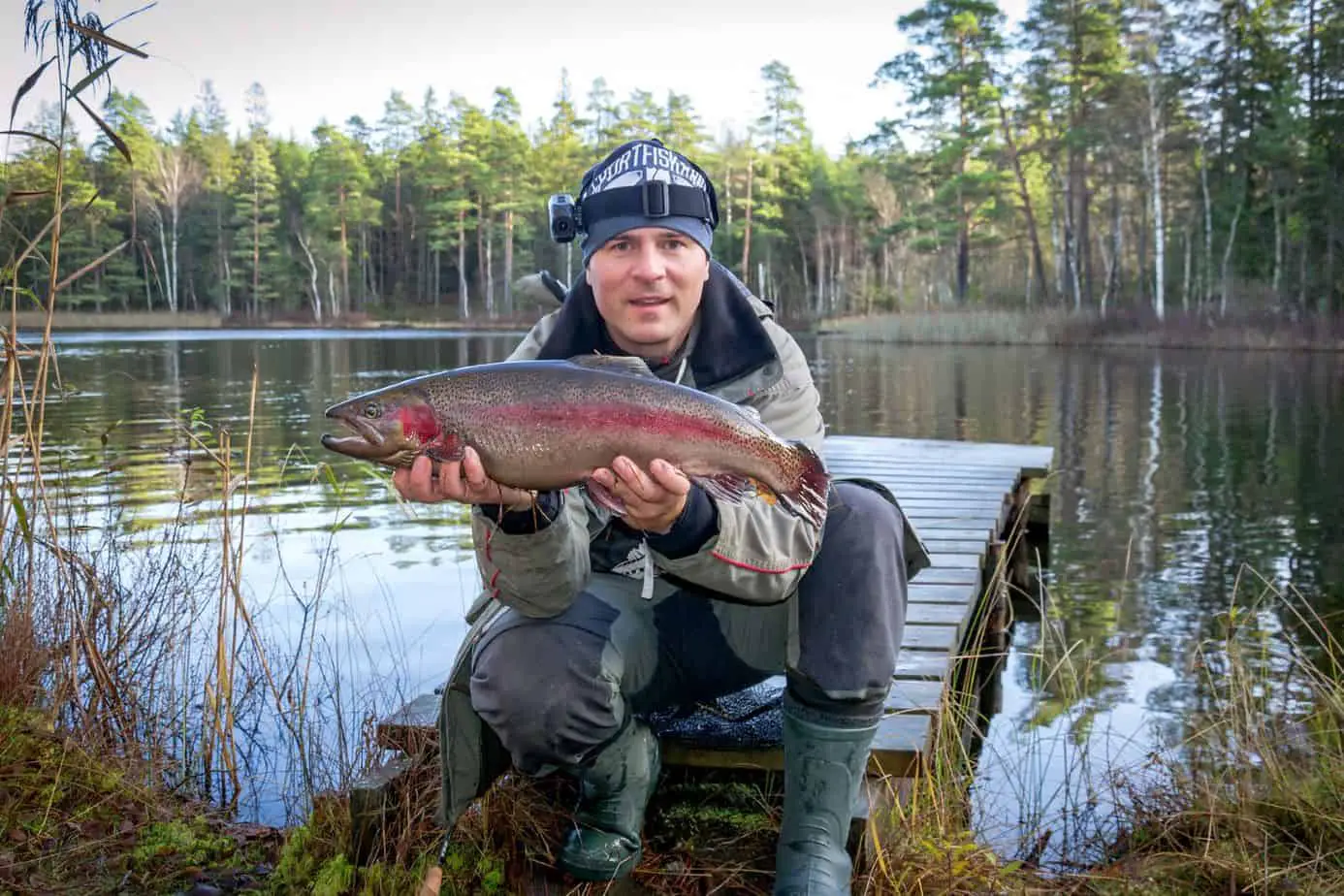Of all the species that fly anglers like to target, trout reign supreme. In the trout family, rainbow trout are super popular and can be located in various areas of the world. The beautiful colors pop to the eye and make rainbow trout trophy fish despite not being super large in many areas.
Fishing for rainbow trout is enjoyable and helps you connect with the beautiful nature around us. This makes this species very sought after by anglers. To have the most success possible when on a rainbow trout fishing excursion, you need to know what flies can produce better results.
Some of the most productive rainbow trout flies include:
- Pheasant Tail Nymphs
- Elk Hair Caddis
- Parachute Adams
- Crayfish
- Quill Gordan
- Midge Nymphs
- Woolly Bugger
- Lightning Bugs
- Bunny Leech
Here is a breakdown of the best fly fishing flies for rainbow trout!
Why Does The Type Of Fly Matter For Rainbow Trout Fishing?
In any type of fishing, specifically baits, flies, and lures, the presentation to the target species is super important. You may be wondering, ‘why does picking the right style of fly matter?”
This is a valid question, but it is also crucial to understand before picking out flies.
The type of fly matters tremendously because your entire goal is to trick the fish into thinking that your fly is an actual meal and getting it to commit. The general rule is to “match the hatch.” This means that you should be using a fly that closely imitates what that rainbow trout naturally feeds on in the specific area.
If you’re interested in additional information on fly fishing flies, read “Different Types of Fly Fishing Flies” or “What Is The Difference Between Wet Flies And Dry Flies?”
So, doing a little bit of research about your specific area and what can be found is huge. Today, we will be diving into some of the more general flies that are great for rainbow trout in many areas. Some may work for your specific location, and some may not, but it is up to you to figure out how each one can benefit you, if at all.

Best Rainbow Trout Flies
Pheasant Tail Nymph
This list isn’t necessarily in order from best to worst, but one of the top options is the pheasant tail nymph. Nymphing is super popular when targeting trout as opposed to a traditional dry fly. To learn more about nymphing, see a previous blog here.
What makes the pheasant tail variation so great is its versatility. Instead of focusing on one specific nymph to imitate, it covers a good range with its build and general color scheme. So, this is a great one to have on deck, no matter where you are.
Plus, they are very affordable, and you can buy them in bulk. This is an everyday fly for many anglers, so they go through many over time. Since they are not very expensive, you can do the same very quickly. To check out the current price right now, click here.
Elk Hair Caddis

Nymphs submerge under the water, but dry flies stay on the surface. Dry fly fishing is known as the more traditional and conventional way to go. One of the best dry flies for trout is the elk hair caddis.
Caddisfly is a very well-known species of fly that is in many areas around the world. These are also a favorite amongst trout, so using a fly to imitate this species is an excellent idea.
Elk hair is a popular, strong material used in fly fishing. Elk hair is very durable, and its texture allows for a little bend in the structure. This is a huge perk to keep in mind because cheaper materials will need to be replaced more often. Some variations can also be made from deer and moose hair. These animals carry some of the same properties.
These generally carry gold, copper, bronze, and brown tones. This is super enticing because it matches up with the actual caddisfly very well.
These should be mainstays in your fly box no matter what species you are fishing for, especially for trout. Having a few of these on hand at any moment can be a difference-maker. Although these might be a little more expensive than some of the other flies on this list, they last a long time, so you won’t have to replace them that much. Here is the current price of the elk hair caddis.
Parachute Adams

One of the highest-regarded flies in the entire industry is the Parachute Adams. Specifically, this fly is known to be one of the greatest trout flies ever made. Obviously, this is subjective, but they deliver results on another level.
This is a dry fly that should probably be in everyone’s arsenal at some point in time. This is because of its versatility and popularity. These are great for streams, rivers, and other moving bodies of water. The body sits on the surface with hair shooting out in four different directions. This makes the presentation super versatile.
The color scheme and build of the fly resemble many different species of flies and insects. This is where versatility comes into play. When you can cover a broad range of insects, you are more likely to get a bite. This is what comes with the Parachute Adams.
One of the best aspects of the Parachute Adams fly is its customizability. There are many variations and sizes available for this fly. That allows you to cater your presentation in the best possible way to match the specific situation.
Depending on the size, these can be super affordable and cheap enough to buy in bulk and keep on deck. This ensures that you won’t run out while in the field. No one wants not to have a fly that is working when out on the water. To see the current price, click here.
Crayfish

Sometimes, you need to think outside of the box. When the normal flies or nymphs aren’t doing it, you need to mix it up and throw a presentation that you may not usually think of using. A fly that falls into this category is the crayfish.
The hair of the fly is crafted to look like an actual crayfish. Luckily, the system has been tuned very well to give the fly a natural look while also not making it too heavy to cast.
Crustacean flies are very often overlooked, especially when fishing for trout in freshwater. As the name implies, the fly imitates a crayfish and will sit on the surface to entice the fish below. These usually aren’t daily users. You will probably stick to some more traditional flies, but the crayfish could be thrown out when those trusty flies just aren’t doing the job.
So, having a fly or two like the crayfish will have that trick in the bag when you need it. Plus, it can be super fun to use something that generally would be disregarded.
These will be one of the more expensive flies on this list, but there is a reason behind it. Because this is a fairly niche fly, they are bigger and are not produced in mass like many others. You also do not have to buy a bunch of flies at once. Since you probably aren’t going to be using them all the time, you can just have a couple on deck. To check in on the current price, click here.

Quill Gordon

A classic fly to use for trout is the Quill Gordon. Although it is a classic, it is one of the more advanced presentations out there. This is a fly for a little more advanced anglers because of its build and how you present it.
So, let’s break down the Quill Gordon. It was created by Theodore Gordon. If you know anything about fly fishing history, you know this name. Gordon is considered one of the founding fathers of dry fly fishing. So, to use a fly created by him is a big deal.
What makes this fly so advanced is the materials it is made of. The body is made of peacock herl. This is not a material that is found in many places. So, if you want to make your own flies, this poses a challenge. If you’re going to buy them already made, they will be a bit more expensive. To see what they are currently selling for, look here.
The quill name comes from the color scheme. The up-shooting hair closely resembles the colors of a quail. Obviously, trout do not eat quail, but this is a great fly that imitates some local insects. This is a fantastic fly if you want to step up your game and take your fly fishing knowledge to new heights.
Midge Nymphs

As we bring the conversation back to nymphs, midges are one of the mainstays within this world of fly fishing. A midge is a species of insect that is basically a gnat. Although there are other midges besides gnats, this is the main type of insect you are working on imitating.
Because nymphs don’t imitate adult insects, this nymph is designed to represent a larva that lives beneath the water before blossoming and going into the world above. Midge nymphs are super simple in design and do not have a lot of flair. The flair is left for the dry flies because nymphs are far smaller and more subtle. This is precisely what you want your nymph to be. Not too flashy, but just enough to catch the eye of a swimming trout.
The term “midge nymph” is a broad stroke because the midge’s actual pattern can vary. There are red, zebra, bronze, and many more options. There is no right or wrong pattern, but the dark reds and zebra colorways are usually the most popular. Either way, going with a midge nymph is an excellent way to target out those finicky trout.
These can be very affordable or slightly pricey based on the type being purchased. They are produced in mass, so that is how you can get them for cheap. Otherwise, hand-tied and higher-end models will cost a bit more. To check in on the current price, click here.
Woolly Bugger

One type of fly that has yet to be covered is the streamer. Like a nymph, a streamer is fished und the water’s surface, but the presentation is entirely different. Streamers are far larger and use various furs to create a wispy wiggle under the water. Like how a nymph represents flies in the nymphal stage of development, a streamer can imitate fish fry rather than a traditional fly.
So, of the streamers on the market, probably the most well-known is the woolly bugger. The woolly bugger’s biggest attribute is its versatility. Like some of the other flies listed excel in their specific fly fishing areas, this one excels in the streamer category.
This streamer can imitate a wide range of possibilities. There aren’t many presentations out there that can represent a leech, a bug, a larger nymph, and various insects all in one go. This is why the woolly bugger can be so efficient.
This can become a presentation you use when nothing else is working. This allows you to cover a broad range of possibilities all in one fly. They also come in many colors to try to specify the color to fit a specific insect being imitated.
For such a large looking fly compared to the others, woolly buggers are very affordable. You can buy them by the dozen, so you will always have some on deck when needed. To see what the current price is, look here.
Lightning Bugs

On the same token of thinking outside of the box, a lightning bug fly is a really cool way to target trout. These are unique because they do not represent the traditional fly that you have come to know. Lightning bugs are similar but take on a slightly different body, shape, and color.
A traditional lightning bug fly has a copper ribbing to imitate the bright part of the lightning bug. This is usually complemented by hair shooting out of the back of a similar color. A lot of creative freedom comes with how the upper end of the fly is dressed. Some typical color schemes include red tinsel, hints of blue, silver, and green.
If you are tying the fly yourself, this is easily customizable, and there are no set rules about what can and can’t be included. If you are buying them already tied, which is what most anglers do these days, you have to pay attention to the specific pattern and survey the options out on the market. To see the price of one variation of the lightning bug fly, click here.
This is another one of the flies that you probably won’t use all the time and is designed for specific situations. It is really important to have these types of presentations available. These are usually best at dusk because lightning bugs are naturally out and about in many areas.
Bunny Leech

The bunny leech is quite similar to the woolly bugger, with a few changes that make it just different enough to divide the population of enthusiasts.
The woolly bugger is super popular and captures the hearts of a lot of streaming anglers. This is because it tried and true properties that are known to catch big fish. Its build is what has captivated fly fishers over the years.
However, some of the community thinks that the Bunny Leech swoops in and takes the cake for the best streamer out there. Many bunny leech fans quote the rabbit fur that elevates it to the next level. Unlike the woolly bugger, the primary material associated with the bunny leech is rabbit fur. There is something about this fur’s properties that do the trick in the water.
Several color variations work quite well. Some of the popular options include purple, white, brown, and black. Regardless of what color you go with, be prepared to handle some hookups.
As we already discussed, streamers are sub-surface presentations that fire up trout lower in the water column. The flair of the bunny leech is perfect for this exact presentation.
These aren’t necessarily the most expensive flies out there, but they aren’t the cheapest either. So, you can reasonably have a few on hand when you need them without breaking the bank. To see the current price of a bunny leech, click here.
Conclusion
These rainbow trout flies should be in your fly box whenever you think there are rainbows in the area. These flies are also perfect choices for brook or steelhead. So if the rainbows aren’t biting, you’re not out of luck.
If you’d like to learn more about some great fly fishing gear, read:


